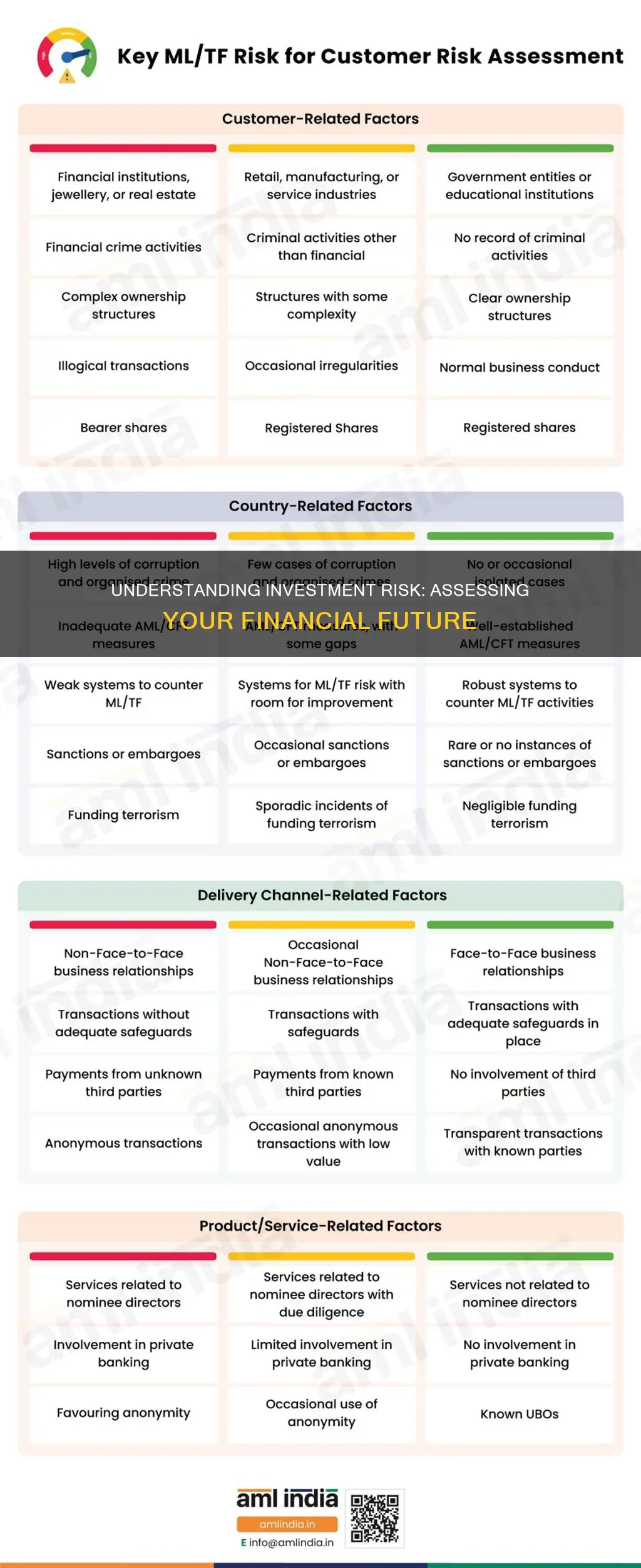
Risk assessment is a process used by corporations, governments, and investors to assess the probability that an adverse event might negatively impact a business, economy, project, or investment. Risk analysis provides different approaches to assess the risk of a potential investment opportunity. Quantitative risk analysis uses mathematical models and simulations to assign numerical values to risk, while qualitative risk analysis relies on a person's subjective judgment to build a theoretical model of risk for a given scenario.
| Characteristics | Values |
|---|---|
| Purpose | To determine the rate of return an investor would need to earn to deem an investment worth the potential risk |
| Definition | The process of analysing potential events that may result in the loss of an asset, loan, or investment |
| Who uses it | Companies, governments, investors, mortgage lenders, portfolio managers |
| Types | Quantitative risk analysis, qualitative risk analysis |
| Quantitative risk analysis | Uses mathematical models and simulations to assign numerical values to risk |
| Qualitative risk analysis | Relies on a person's subjective judgment to build a theoretical model of risk for a given scenario |
| Example of quantitative risk analysis | Monte Carlo simulation |
| Example of formal risk assessment technique | Conditional value at risk (CVaR) |
What You'll Learn

Qualitative vs quantitative risk analysis
Risk assessment is a process that helps investors determine the rate of return they would need to earn to consider an investment worth the potential risk. It involves analysing potential events that may result in the loss of an asset, loan, or investment.
There are two types of risk analysis that investors can apply when evaluating an investment: quantitative analysis and qualitative analysis.
Quantitative risk analysis uses mathematical models and simulations to assign numerical values to risk. This approach enables investors to build risk models and simulations that can be used to assess the potential outcomes of an investment. For example, a Monte Carlo simulation runs a number of variables through a mathematical model to discover the different possible outcomes. This method can be applied in various fields, including finance, engineering, and science.
On the other hand, qualitative risk analysis relies on a person's subjective judgment to build a theoretical model of risk for a given scenario. This type of analysis takes into account factors such as a borrower's credit score, available assets, collateral, income, or cash on hand. It is often used by lenders for personal loans, lines of credit, and mortgages to assess the creditworthiness of potential borrowers.
Both types of risk analysis have their advantages and disadvantages. Quantitative analysis provides a more objective and data-driven approach, while qualitative analysis can offer insights into more subjective or intangible factors that may impact risk. It is important for investors to consider both types of analysis when evaluating an investment opportunity to make a well-informed decision.
Additionally, it is worth noting that while a stock's past volatility can be an indicator of risk, it does not guarantee future returns. Investments with high volatility may be riskier, but it is not a definitive predictor of future performance, especially during rapidly changing market conditions.
Retirement Investments: Best Places for Your Savings
You may want to see also

Risk models and simulations
Risk assessment is important for investors to determine the rate of return they would need to earn to make an investment worth the potential risk. Risk assessment is the process of analysing potential events that may result in the loss of an asset, loan, or investment.
Quantitative risk analysis involves building risk models and simulations that enable the user to assign numerical values to risk. An example of a quantitative risk analysis method is a Monte Carlo simulation, which runs a number of variables through a mathematical model to discover the different possible outcomes. This method can be used in a variety of fields, including finance, engineering, and science.
Another example of a formal risk assessment technique is conditional value at risk (CVaR), which portfolio managers use to reduce the likelihood of incurring large losses. Mortgage lenders use loan-to-value ratios and credit analysis to evaluate the risk of lending funds. Standard deviation is also a measure used to assess the volatility of an investment, with higher volatility indicating a riskier investment. However, it's important to note that a stock's past volatility does not predict future returns.
Understanding Personal Risk Tolerance for Smart Investments
You may want to see also

Risk and return
There are two main types of risk analysis: quantitative and qualitative. Quantitative risk analysis uses mathematical models and simulations to assign numerical values to risk. This method can be applied to various fields, including finance, engineering, and science. An example of a quantitative risk analysis technique is the Monte Carlo simulation, which runs multiple variables through a mathematical model to uncover different possible outcomes. On the other hand, qualitative risk analysis relies on an individual's subjective judgment to create a theoretical model of risk for a given scenario.
Standard deviation is a measure used to assess the volatility of an investment's annual rate of return. Generally, an investment with high volatility indicates a riskier investment. However, it is important to note that past volatility does not guarantee future returns. Investments with previously low volatility can experience sharp fluctuations, especially during rapidly changing market conditions.
Another formal risk assessment technique is conditional value at risk (CVaR), used by portfolio managers to reduce the likelihood of incurring substantial losses. Mortgage lenders also conduct risk assessments, known as credit checks, to evaluate the creditworthiness of borrowers. They consider factors such as available assets, collateral, income, and cash on hand.
Exploring CD Investments: Turning $2000 into More
You may want to see also

Risk and volatility
There are two types of risk analysis an investor can apply when evaluating an investment: quantitative analysis and qualitative analysis. Quantitative analysis of risk focuses on building risk models and simulations that enable the user to assign numerical values to risk. An example of this is a Monte Carlo simulation, which runs a number of variables through a mathematical model to discover the different possible outcomes. Qualitative risk analysis, on the other hand, relies on a person's subjective judgment to build a theoretical model of risk for a given scenario.
Standard deviation is a measure applied to the annual rate of return of an investment to measure its volatility. In general, an investment with high volatility indicates a riskier investment. However, it is important to note that a stock's past volatility does not guarantee future returns. Investments that previously experienced low volatility can experience sharp fluctuations, particularly during rapidly changing market conditions.
Foreign Indirect Investment: India's Global Economic Strategy
You may want to see also

Risk and creditworthiness
There are two main types of risk analysis: quantitative and qualitative. Quantitative risk analysis uses mathematical models and simulations to assign numerical values to risk. Qualitative risk analysis relies on a person's subjective judgment to build a theoretical model of risk for a given scenario. An example of a quantitative risk analysis method is a Monte Carlo simulation, which can be used in a variety of fields such as finance, engineering, and science. This method runs a number of variables through a mathematical model to discover the different possible outcomes.
Creditworthiness is an important factor in investment risk assessment, particularly for lenders. Lenders conduct risk assessments, known as credit checks, to determine the creditworthiness of borrowers. This involves analysing factors such as credit scores, available assets, collateral, income, or cash on hand. Lenders will typically not approve borrowers with credit scores below 600, as lower scores are indicative of poor credit practices.
Standard deviation is a measure used to assess the volatility of an investment. In most cases, an investment with high volatility indicates a riskier investment. However, it's important to note that a stock's past volatility does not predict future returns. Investments that previously experienced low volatility can experience sharp fluctuations, particularly during rapidly changing market conditions.
Monitoring Your Investment Portfolio: How Frequently Should You Check?
You may want to see also
Frequently asked questions
An investment risk assessment is a process of analysing potential events that may result in the loss of an asset, loan, or investment.
There are two types of investment risk assessment: quantitative analysis and qualitative analysis.
Quantitative analysis uses mathematical models and simulations to assign numerical values to risk, whereas qualitative analysis relies on a person's subjective judgment to build a theoretical model of risk for a given scenario.







